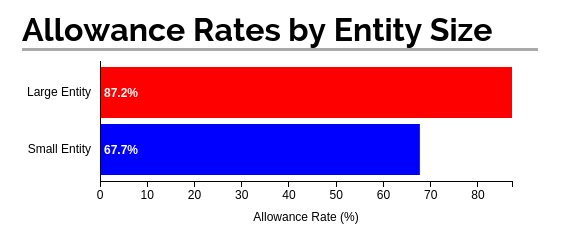Here at Juristat, we are often asked whether an entity's size affects its allowance rate for patents. We’ve run the numbers, and the results may be more skewed than you expect.
ENTITY CLASSIFICATIONS
When prosecuting a patent, an applicant’s fee structure depends largely on the size of the entity. For example, fees charged under 35 U.S.C. 41(a) are reduced by 50% for small entities.¹ The same fees are reduced by 75% for micro entities.
The following may qualify as small entities: (1) an individual person, (2) a small business concern, or (3) a nonprofit organization.² In addition to meeting other requirements, a small business concern must have no more than 500 employees.³ As summarized by Dennis Crouch at Patently-O, on top of these requirements, a micro entity must be able to answer “no” to the following questions:
1. Has the entity been the inventor on more than four previously filed non-provisional U.S. patent applications? 2. Did the entity’s income from the last year exceed $155,817 (three times the median household income as most recently reported by the Bureau of the Census)? 3. Has the entity assigned, granted, or conveyed a license or ownership interest in the application or is the entity otherwise under an obligation to assign, grant, or convey such an interest to an entity whose income exceeds the requirements in question 2?
A COMPARISON OF ALLOWANCE RATES
We initially ran the numbers on large, small, and micro entities. However, the micro entity was established on March 19, 2013, so it is too soon to draw any conclusions. Nevertheless, we were still curious about small and large applicants. Accordingly, we compared their allowance rates for applications filed between September 8, 2000 (when modern small entities were established) and March 19, 2013 (when micro entities were established). Here’s what we found:

As you can see, large entities (i.e., those not qualifying as small entities) have a significantly higher chance of success. More specifically, a large entity is 12.5% more likely to receive a patent than a small entity. While it’s too soon to draw any conclusions about the success of micro entities, initial numbers suggest they will prove even less successful.
WHY ARE LARGE ENTITIES MORE SUCCESSFUL?
This is not an easy question to answer. At this point, we can only speculate. Clearly, by definition, larger organizations have more resources. This undoubtedly gives them greater access to top-notch inventors and law firms. Moreover, large entities aren’t born large. They grow over time. Most businesses exist for many years before employing 500+ people. A longer existence means more potential exposure to the patent process.
Another possible factor is the America Invents Act (AIA), signed into law by President Obama in September 2011. The AIA established the “First-to-File” system which gives priority to inventors who file first. Some attorneys believe this system favors large companies. Such companies can afford to inundate the USPTO with under-developed patent applications, thereby preserving earlier filing dates. Juristat hopes to test this theory as more data becomes available.
TAKEAWAY
This much is clear: large entities are significantly more successful than small entities. We can’t say for sure why this discrepancy exists. Nevertheless, it’s a compelling statistic that should be of particular interest to applicants invoking small entity status.
Authored by Austin Underhill & Samuel Vincent
(gradient).webp)
